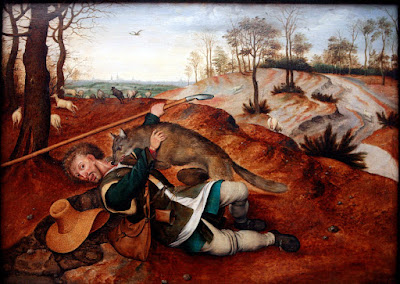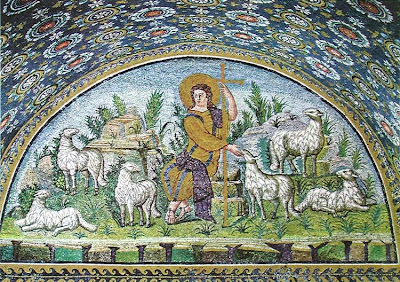We've been singing this lovely fraction anthem at the Eucharist during Eastertide; it's S167 in the 1982 Hymnal. The setting cited there is "Mode 6 melody, adapt. Mason Martens (b. 1933)." The parts in italics below are congregational; the other lines are sung by a soloist in the choir.
Fisheaters mentions the original verse/response on their Easter page:
Searching on "Et apparuit Simoni" brought up this page at Cantus database - and the numerous links to the phrase in various manuscripts, including a few images. The Verse/Response was used at many different offices throughout at least the Octave of Easter - although DivinumOfficium has it used mainly, as far as I can tell, as the Verse/Response before the first reading at Matins in early Eastertide. (Searching just "Surrexit Dominus vere" brings up lots of citations - this one, for example - but we're interested in including the "Simoni" ("Simon") language, since that does seem to be part of this antiphon in particular. The reference for all of these is from Luke, and "Surrexit Dominus vere," with or without "Simoni," is used frequently throughout Eastertide, as you can imagine.)
For instance, this is from the Antiphonarium Massiliense 1201-1300 (a book from Marseille, France):
And this is from Fribourg/Freiburg, Couvent des Cordeliers/Franziskanerkloster: (an "Antiphonary for Franciscan use")
Here, the Schola Cantorum de Regina Pacis (Klaipeda, Lithuania) sings it:
And there's a Taize Surrexit dominus vere, also:
The disciples knew the Lord Jesus in the breaking of the bread.I searched for audio or video of this online, but to no avail. Then, I happened to stumble upon the Easter antiphon Surrexit Dominus Vere - I can't remember how or why - and lo and behold: this is the very same melody sung by the soloists in the fraction anthem above. (The congregational response is very beautiful, but not part of this antiphon, apparently.) Here Giovanni Vianini sings it:
The bread which we break, alleluia, is the communion of the body of Christ.
The disciples knew the Lord Jesus in the breaking of the bread.
One body are we, alleluia, for though many we share one bread.
The disciples knew the Lord Jesus in the breaking of the bread.
Fisheaters mentions the original verse/response on their Easter page:
On this, the holiest day of the entire year, and for the entire Octave of Easter, Latin Catholics greet each other with the words of Luke 24:34, "Surrexit Dominus vere, alleluia!" ("The Lord is risen indeed!"). The person so greeted responds, "Et apparuit Simoni, alleluia!" ("And hath appeared unto Simon!"). Catholics may even answer their telephones with this greeting. An old Ukrainian legend relates that, after His Resurrection, Christ threw Satan into a deep pit, chaining him with twelve iron chains. When Satan has chewed through each of the twelve chains, the end of the world will come. All year long, the Evil One gnaws at the iron, getting to the last link in the last chain -- but too late, for it is Easter, and when the people cry "Christ is risen!" all of Satan's efforts are reversed. When the faithful stop saying the Easter acclamation, the end of time has come...
Searching on "Et apparuit Simoni" brought up this page at Cantus database - and the numerous links to the phrase in various manuscripts, including a few images. The Verse/Response was used at many different offices throughout at least the Octave of Easter - although DivinumOfficium has it used mainly, as far as I can tell, as the Verse/Response before the first reading at Matins in early Eastertide. (Searching just "Surrexit Dominus vere" brings up lots of citations - this one, for example - but we're interested in including the "Simoni" ("Simon") language, since that does seem to be part of this antiphon in particular. The reference for all of these is from Luke, and "Surrexit Dominus vere," with or without "Simoni," is used frequently throughout Eastertide, as you can imagine.)
For instance, this is from the Antiphonarium Massiliense 1201-1300 (a book from Marseille, France):
And this is from Fribourg/Freiburg, Couvent des Cordeliers/Franziskanerkloster: (an "Antiphonary for Franciscan use")
Here, the Schola Cantorum de Regina Pacis (Klaipeda, Lithuania) sings it:
Surrexit Dominus vere, alleluia, alleluia. Et apparuit Simoni, alleluia, alleluia. Glória Patri, et Fíllio, et Spirítui Sancto.It seems several composers have set the text; here are the words from Jacquet de Bechem's setting. He includes the text from the Gradual for Easter Day, Haec dies:
Viešpats tikrai prisikėlė, aleliuja, aleliuja. Ir pasirodė Simonui, aleliuja, aleliuja. Garbė Dievui Tėvui, ir Sūnui, ir Šventajai Dvasiai.
FIlmuota 2010 m. balandžio 25 d. Klaipėdos šv. Kazimiero bažnyčioje.
Schola Cantorum de Regina Pacis choir is based in the church of St. Mary, Queen of Peace (Klaipeda, Lithuania)
More info: www.regina-pacis.org
Alleluia. Quia surrexit Dominus vere,
et apparuit Simoni, alleluia.
Exultemus et laetemur
dies ista laetitiae.
Haec dies, quam fecit Dominus
Exultemus et laetemur in ea.
Alleluia.
Alleluia. The Lord has truly risen
and appeared to Simon, alleluia.
Let us rejoice on this day of joy,
which the Lord has made;
let us rejoice in it.
And there's a Taize Surrexit dominus vere, also:























